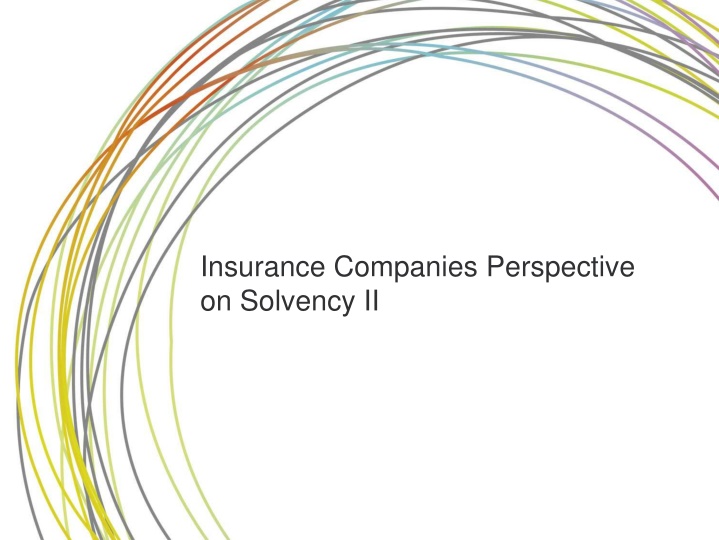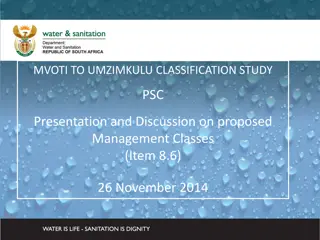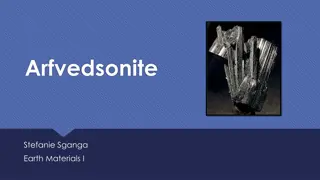
Insurance Companies Perspective on Solvency II and Ageas SA/NV
"Explore the regulatory framework of Solvency II, the road to implementation, and Ageas SA/NV's role in the insurance industry. Learn about the background, reasons for replacing Solvency I, and the scope and mission of Solvency II directive. Understand the impact on policyholders and the insurance industry in Europe and Asia."
Download Presentation

Please find below an Image/Link to download the presentation.
The content on the website is provided AS IS for your information and personal use only. It may not be sold, licensed, or shared on other websites without obtaining consent from the author. If you encounter any issues during the download, it is possible that the publisher has removed the file from their server.
You are allowed to download the files provided on this website for personal or commercial use, subject to the condition that they are used lawfully. All files are the property of their respective owners.
The content on the website is provided AS IS for your information and personal use only. It may not be sold, licensed, or shared on other websites without obtaining consent from the author.
E N D
Presentation Transcript
Insurance Companies Perspective on Solvency II
Content What is Ageas ? SII in a Nutshell Road to SII Nobody is perfect Ageas specificities International development Conclusion April 2018 1
What is ageas SA/NV (Ageas) ? Ageas is an insurance holding Ageas has a history which involved banking and insurance but now we are only in insurance business active in Europe and Asia. Consequently, I will not deal in this presentation with IDD and I will also elaborate on solvency issues outside the EU. April 2018 2
SII in a Nutshell Background Solvency I Regulatory required capital for insurers to cover liabilities existing from 70s Review initiated in the 90s & implemented in 2002 First european directive defining the required capital Each country could derive its own national regulation Statutory approach to quantification solvency margin & risk Ex: Required capital life liabilities: 4% of legal reserves Road to Solvency II Awareness need for more extensive reform than Solvency I Need to market value assessment based on real risks Parallel evolution with Basel regulations & process IFRS/IAS April 2018 3
SII in a Nutshell Reason to replace Solvency I Eliminate limitations of the Solvency I regime: Orientation towards past (based on a cut-off date) Composition of the portfolio is not taken into account Limited & inadequate consideration given to reinsurance No allowance for risk correlations Theoretical risk approaches are not taken into account Besides there was also a diversity of developments that impacted the insurance business: The downwards interest movement (Japanese scenario) Increasing longevity A series of new financial products with increasing complexity (derivatives, securitization, etc.) Further and fast development of markets, insurance products and technology April 2018 4
SII in a Nutshell Scope & Mission Scope Applicable to all types of insurance companies, life insurance companies, non-life or joint, mutual & institutions de pr voyance WARNING: Pension funds are not affected Main purposes of the Solvency II Directive are: Increase the protection of policyholders Create a level playing field for the insurance industry in the European Single market Ensure substantially uniform supervisory practices throughout Europe April 2018 5
SII in a Nutshell Key elements From simplistic (volume based) but stable Solvency I to realistic (risk based) but more volatile Solvency II > Solvency Capital Requirement (SCR) > Based on effective risks taken within company, covering both assets & liabilities > Required capital influenced by risk mitigation actions Risk based approach Market consistent valuation > Reflecting economic situation vs. accounting view > Available capital (Own Funds) on market value / marked to model basis European regulation > In principle more level playing field > Three-pillar framework strives for an integrated risk view > More complex > Integrated risk view > Choice between standard formula or (partial) internal model Framework 6 April 2018
SII in a Nutshell 3 Pillars All equally important: April 2018 7
SII in a Nutshell Example: The market risk module General impact on market risk capital charge, before any diversification benefit : Under Solvency I, two companies could share the same ratios based on their overall liability, whilst their risk profiles could be very different Capital charge for 100 investment (before correlation) Equity investments become extremely expensive Asset Class / Risk Type Solvency I Solvency II - DIM EQUITIES Direct real estate consumes less capital than indirect real estate Type 1* 4 4 4 4 4 39 SA 49 SA 22 25 25 Type 2* Strategic Participation REAL ESTATE FX CREDIT RISK Euro-Govies are the winner Government Bonds (OCDE & EEA) 4 0 Government Bonds (other than OCDE & EEA) Covered Bonds Required capital credit risk function of rating & duration Depend on both Rating and Duration * It is easier to compare risks under Solvency II than Solvency I 4 Credit Repackaged Loans (resecuritisation) Repackaged Loans (other than resecuritisation) CONCENTRATION RISK - by Ultimate Parent Interest rate mismatch (duration gap) can be very expensive ALM RISK Interest rate mismatch - worst NPV Type 1 = EEA/OECD equities listed in regulated markets ;Type 2 = other equities ; SA= Symmetric Adjustment April 2018 8
April 2018 10
Road to SII 6 Quantitative impact studies (QIS) to avoid disruption Costly exercise: Between 3 and 4 billion euro cost for the industry (IT, human commitment ) Close to 100 risk specialists have been involved in preparation in recent years at Ageas April 2018 11
Nobody is perfect Concerns over Inappropriate treatment of the illiquidity premium for valuation of the liabilities materialising in misalignment between spread volatility and the absorption of non-fundamental spread volatility with the Volatility Adjustment Treatment of sovereign bonds Impact on competition (level playing field), Ultimate forward rate (UFR) used to calculate the long-term liabilities The review of Solvency II is a formal process following the legislative texts from the Solvency II Directive: Recital 150 of the Solvency II Delegated Regulation defines a timeline for the review of the SCR standard formula, the first phase of the review, which should be finalised by the European Commission before December 2018. The Solvency II regime as a whole will be reviewed by 2021. We believe, however, that insurers and supervisors will benefit from a period of stability, allowing time for the new regime to bed down. April 2018 12
Nobody is perfect Volatility Adjustment Balance Sheet contains Basis risk Potential solution under Pillar I: Align asset mix with reference portfolio April 2018 13
Nobody is perfect Treatment Sovereigns Solvency II requires no capital charge for European Sovereign Bonds Ageas applies a capital charge for the potential losses linked to default or losses in case of sales under stressed market value (= Fundamental spread) April 2018 14
Ageas Specificities PIM (Partial Internal Model) improvies standard formula with an internal model for Non-Life Riks. For Internal Use, we adapt the solvency treatment for pillar 2 as follows: Treatment non-fundamental spread more adapted to our investment strategy o Exclude non-fundamental spread risk on Corporates o Include fundamental spread risk on Government exposure Treatment Real Estate investments more adapted to economical reality Transitional measures at local level are removed Preference for prudent view on transitional measures Deduct amount of diversification benefits between controlled entities Asia Non-European Non-controlled participations not included April 2018 15
International Developments International evolution towards risk based Solvency frameworks : Asia: C-Ross in China, Asset valuation Under Solvency II this is market to market and in the C-ROSS this is China GAAP. Discounting yield Under Solvency II the base yield curve for liability discounting is the current risk-free curve, while C-ROSS utilises the 750-day moving average of the government bond yield curve. Real estate risk The risk charge factors for real estate under C-ROSS are much lower than under Solvency II. Overseas asset riks Unlike for Solvecy II, there exist specific risk charges for overseas fixed income and overseas equity. Currency risk Is lower under C-ROSS than under Solvency II. International Capital Standards (ICS) International trend towards Market Consistent Balance Sheets: o IFRS 9 o IFRS 17 April 2018 16
Conclusion Solvency II has put a framework in place that reflects much better the actual risks taken by improved quality & use of data transparency awareness of risk While Solvency II may not yet be ideal, there are review processes built into the legislation that should be used to improve it Consumer transparency has definitely improved under Solvency II allowing easier risk assessment of an insurance company. Big question becomes who pays? At the end of the day, the customer pays for this quality assurance and additional security. April 2018 17






















